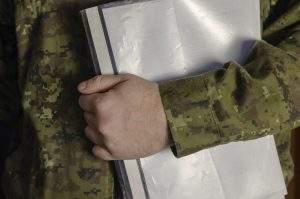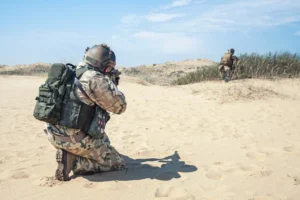NORTH SEWICKLEY TWP. — Along Grandview Road, in front of a house not far from Holy Redeemer Cemetery, stands a war veteran’s grave marker.
The marker, which commemorates service in World War II, is of the type generally seen in cemeteries like the one just uphill — at the graves of military veterans, not in the front yards of a residential property. And it signifies the story of an unusual local veteran.
The front-yard grave marker serves as tribute to a war veteran who walked on four paws.
Aside from the burial site, somewhere in that yard along Grandview Road, not much is known about Ginger the war dog, who passed away more than 50 years ago.
It’s believed that Ginger served with the Army in the European Theater of Operations during World War II. Greg Rogers, of Ellwood City, owns the property where Ginger is buried. Rogers’ grandfather owned Ginger after the war.
Rogers said he knows very little of Ginger’s war service, aside from reports that the dog was wounded in action against the Germans. He believes Ginger was a German shepherd but can’t remember whether Ginger was male or female.
“I think the dog was actually shot a couple of times,” Rogers said.
The use of dogs in war has been common in the 20th century, most notably by the Marine Corps in the Pacific Theater during World War II.
The Marines’ most well-known use of dogs came in the 1944 operation to retake Guam, a U.S. territory before the war that was captured by the Japanese. The Marine 2nd and 3rd War Dog Platoons took part in the invasion, according to a 2014 article in Stars and Stripes Magazine.
A memorial to Marine war dogs still stands on the naval base at Guam, in memory of 25 canines that lost their lives during the battle. The most famous of the fallen war dogs was Kurt, a Doberman who was credited with saving the lives of 250 Marines during the invasion of Guam. Kurt’s likeness sits atop the Guam monument.
Veterinarian and retired Marine Capt. William Putney led the 2nd and 3rd War Dog Platoons and wrote the book “Always Faithful: A Memoir of the Marine Dogs of World War II.” The title of Putney’s book refers to the Marine Corps motto, “Semper Fidelis,” Latin for “Always Faithful.”
The dogs proved so valuable on Guam that every Marine division was assigned a war dog platoon, and they paved the way for the many dogs that have followed them in the armed services, most famously in Vietnam,” Putney wrote.
One of those Vietnam War dogs — an Army canine — had another Ellwood City connection. On April 8, 1970, an element of 2nd Platoon, Bravo Company, 3rd Battalion, 506th Infantry Regiment, 101st Airborne Division, was “humping the boonies” — in infantryman-speak, looking for the North Vietnamese.
Leading the column, which included 1966 Lincoln High School graduate Leslie H. Sabo Jr., was a military dog trained to catch the scent of enemy soldiers. The dog had a scent “hit,” but a two-man scout team sent to locate North Vietnamese could find nothing.
A few minutes later, the dog caught the enemy’s scent, immediately followed by an ambush. Two soldiers and the dog were killed in the ensuing firefight, according to the 2015 book “Company of Heroes.” But the dog’s alertness might have saved additional lives by putting the soldiers in a higher state of alert.
About five weeks later, on May 10, 1970, Sabo was killed during combat in Cambodia. He would receive the Medal of Honor, the U.S. military’s highest award for combat valor, in 2012.
Ginger survived World War II and wound up in North Sewickley Township with a normal dog’s life and was buried at the house along Grandview Road.
While it’s not known exactly what Ginger did during the war, the dog’s service is still remembered by Ellwood City American Legion Post 157, which maintains the World War II veterans grave marker, and by local Boy Scout Troop 806, which places flags in the marker each Memorial Day.
Ginger also is memorialized on Ellwood City’s memorial plaza, in front of the borough’s municipal building. On the side of the easternmost monument, facing the side wall of Grand Paws pet grooming service, the inscription “K-9 CORPS GINGER” can be found on the stone’s lower-right-hand corner.
As befitting Ginger’s singular status, the etching stands alone, separated from the names of the dog’s human veteran counterparts.





